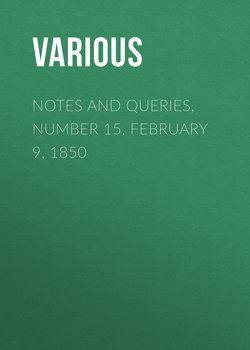Читать книгу Notes and Queries, Number 15, February 9, 1850 - Various - Страница 3
NOTES
NOTES FROM FLY-LEAVES, NO. 6
ОглавлениеIn a copy of Burnet’s Telluris Theoria Sacra (in Latin), containing only the two first books (1 vol. 4to., Lond. 1689), there is the following entry in Bishop Jebb’s hand-writing:—
“From the internal evidence, not only of additional matter in the margin of this copy, but of frequent erasures and substitutions, I was led to suppose it was the author’s copy, illustrated by his own annotations and improvements. The supposition is, perhaps, sufficiently corroborated by the following extract from the Biographia Britannica, vol. iii. p. 18.
“‘It seems it was usual with Dr. Burnet, before he published any thing in Latin, to have two or three copies, and no more, printed off, which he kept by him for some time, in order to revise at leisure what he had written currente calamo, and sometimes, when he thought proper, to be communicated to his particular friends for their opinions, &c.’
“This copy, as it does not differ from any of the editions of 1689, was certainly not one of those proofs. But the Doctor’s habit of annotating on his own Latin books after they were printed, renders it extremely probable that this book was a preparation for a new edition. It would be well to compare it with the English translation.”
The nature of many of the corrections and additions (which are very numerous), evidently shows a preparation for the press. I have compared this copy with the English edition, published in the same year, and find that some of the corrections were adopted; this, however, but in a few instances, while in one, to be mentioned presently, a palpable mistake, corrected in the MS. Latin notes, stands in the translation. The English version differs very materially from the Latin. The author says in his Preface:—
“This English version is the same in substance with the Latin, though I confess, ’tis not so properly a translation, as a new composition upon the same ground, there being several additional chapters in it, and several new moulded.”
The following are examples of corrections being adopted: P. 6. Latin ed. “Quod abunde probabitur in principio libri secundi.” For the last word subsequentis is substituted, and the English has following. P. 35. “Hippolitus” is added to the authorities in the MS.; and in the English, p. 36., “Anastasius Sinaiti, S. Gaudentius, Q. Julius Hilarius, Isidorus Hispalensis, and Cassiodorus,” are inserted after Lactantius, in both. P. 37. “Johannes Damascenus” is added after St. Augustin in both. P. 180. a clause is added which seems to have suggested the sentence beginning, “Thus we have discharged our promise,” &c. But, on the other hand, in p. 8. the allusion to the “Orphics,” which is struck out in the Latin, is retained in the English; and in the latter there is no notice taken of “Empedocles,” which is inserted in the margin of the Latin. In p. 11. “Ratio naturalis” is personified, and governs the verb vidit, which is repeated several times. This is changed by the corrector into vidimus; but in the English passage, though varying much from the Latin, the personification is retained. In p. 58., “Dion Cassius” is corrected to “Xiphilinus;” but the mistake is preserved in the English version.
JOHN JEBB.
